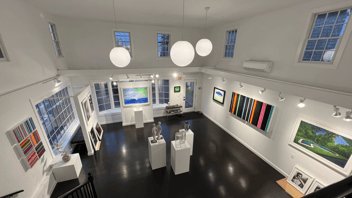Saint-Paul-de-Mausole Asylum: Where Van Gogh Spent His Final Days
Read Alex West's account of Saint-Paul-de-Mausole Asylum — reflecting on mental health, art therapy, and the power of slowing down in building a company.
Yesterday, I had the exciting opportunity to tour the Saint-Paul-de-Mausole Asylum in Saint-Rémy-de-Provence, where Vincent van Gogh spent the last year of his life. It is well-documented that Van Gogh struggled with mental health issues, and this institution provided him with care during his final years. After planning the visit for myself, my wife Emily, and our two children, I discovered that we would be touring the asylum on the 134th anniversary of Van Gogh’s death—a poignant and ironic coincidence.

I was pleased to learn that Dr. Paul Gachet, who treated Van Gogh, recognized the artist’s passion for painting and encouraged him to use it as a therapeutic outlet. This personalized approach is now considered one of the earliest instances of art therapy. Since Van Gogh’s presumed suicide in 1890, our understanding of mental illness has evolved significantly, alongside the public perception of it. However, societal stigmas persist, often resulting in a binary view: on one side, serious mental illness remains unacknowledged due to limited resources or fear of public shame; on the other, the “mad” artist archetype, epitomized by figures like Van Gogh, Edvard Munch, Sylvia Plath, and Amy Winehouse, has become a romanticized narrative in the public imagination.
Van Gogh is often seen as the quintessential tortured artist, with his life story — the severed ear (allegedly mailed to an ex-girlfriend in a fit of despair), his affinity for the color yellow (possibly due to experimental medicine or even ingesting yellow paint), and his tragic death by gunshot—both mythologized and parodied.
Our guide at Saint-Paul-de-Mausole challenged many of the well-worn stories in the pantheon of Van Gogh lore. Alternate theories exist regarding the severed ear incident: one suggests that a dispute between Van Gogh and Gauguin, who often quarreled while living together in Saint-Rémy, ended with Gauguin severing Van Gogh’s ear with a razor blade. Another theory holds that Van Gogh severed his own ear in a fit of rage. Regardless of the exact circumstances, it was a local prostitute, rather than a former lover (not that that she couldn’t have been both), who witnessed the event and was given the earlobe as a “souvenir.”
| Our guide at Saint-Paul-de-Mausole challenged many of the well-worn stories in the pantheon of Van Gogh lore. |
What struck me most during our guide’s reframing of Van Gogh’s story was the reconsideration of the artist’s state of mind at the time of his death. Rather than accepting the notion that Van Gogh was beyond help and that his gunshot wound was self-inflicted, locals tell a different story. Dr. Gachet’s experimental art therapy was reportedly effective, and Van Gogh was believed to be improving. This version of events resonates in the community to this day, and the hospital—still an operating art therapy facility—even partners with the School of Visual Arts in New York to mount an annual exhibition featuring works by both SVA students and Saint-Paul-de-Mausole clients.
 The mysteries within Van Gogh’s biography are a topic that scholars spend their careers investigating, and I don’t presume to have uncovered any definitive answers during my tour. However, as I gazed at the ceiling in Van Gogh’s private room, I found myself wondering how many times he must have stared at the same stucco patterns during sleepless nights, and I was struck by how much about Van Gogh I didn’t know. Although I was familiar with the artist’s mythology, I had never truly stopped to feel what he must have experienced. I had seen much of his work but had never taken the time to appreciate it fully, to contemplate his perspective while painting, or to question the popular narrative of his life.
The mysteries within Van Gogh’s biography are a topic that scholars spend their careers investigating, and I don’t presume to have uncovered any definitive answers during my tour. However, as I gazed at the ceiling in Van Gogh’s private room, I found myself wondering how many times he must have stared at the same stucco patterns during sleepless nights, and I was struck by how much about Van Gogh I didn’t know. Although I was familiar with the artist’s mythology, I had never truly stopped to feel what he must have experienced. I had seen much of his work but had never taken the time to appreciate it fully, to contemplate his perspective while painting, or to question the popular narrative of his life.
In a way, this introspection mirrors the journey of building a company—a journey where the demands and distractions of daily tasks often prevent us from seeing the larger picture. Just as I had overlooked the deeper essence of Van Gogh’s experiences, I had been so consumed by the hustle of growing ArtCloud that I hadn’t fully appreciated the art of the process itself.
| In a way, this introspection mirrors the journey of building a company—a journey where the demands and distractions of daily tasks often prevent us from seeing the larger picture. |
If you delve into the journey of building a company, a consistent theme emerges: the sheer volume of work required. From product development, customer engagement, capital raising, and sales, to team building and marketing refinement, the list of priorities seems endless. Meanwhile, the pressure to achieve results quickly is ever-present, especially when insolvency looms. These stresses have been the undercurrent of my life over the past decade. We founded ArtCloud with a clear vision: to help artists and galleries build better art businesses. A straightforward goal. But the endless distractions and unexpected challenges often clouded our initial clarity.

I’ve always navigated this journey with an attitude of “get it done and move on to the next thing” as quickly as possible. However, as we recently achieved profitability, an incredible sense of ease crystallized. Everything seemed to slow down. For the first time, I felt able to work ‘on’ the business instead of ‘in’ the business. We began focusing on enhancing the platform’s usability instead of hastily implementing critical features to “secure the next customer” (many of which ended up unused and wasted energy). In just six months of this more deliberate pace, I feel we’ve strengthened our core tenfold. We’ve solidified our company values, refined our customer acquisition model, and discovered efficiencies throughout the entire company. Reflecting on this, I am in awe of the power of slowing down and somewhat embarrassed that it took me so long to learn.
Standing in that room at Saint-Paul-de-Mausole, overlooking the lavender fields, sunflowers, and vistas of Saint-Rémy, I couldn’t help but think about Van Gogh contemplating the same view as he painted. I slowed down and appreciated his work on a profoundly different level. This feeling was immensely satisfying. The inspiration was palpable.
Though it remains a challenge and likely will be for some time, I am committed to slowing down, noticing details, and doing less—better.
Learn more about ArtCloud here, and if you'd like to tour our business operations software for galleries, please schedule a demo.

























